- within Family and Matrimonial, Employment and HR and Accounting and Audit topic(s)
- with readers working within the Banking & Credit industries
At a Glance
Location: North of the Equator (Latitude: 8° 4' to
37° 6' North;
Longitude: 68° 7' to 97° 25' East) Capital: New
Delhi
Population: 1.29 billion (2015 -16 estimate) Area: 3.3 million sq
km
Indian Standard Time: GMT + 5:30 Telephone Country Code: +91
Official Language: Hindi is one of the 22 official languages
(English is used for official communication)
Geography and Climate1
Covering an area of 3.3 million sq km, India is the seventh largest country in the world, occupying a major portion of the South Asian subcontinent. Extending from the Himalayas in the north, it stretches southwards to the Tropic of Cancer and tapers off into the Indian Ocean between the Bay of Bengal on the east and the Arabian Sea on the west.
India's climate varies significantly from the permanently snow-capped Himalayas in the north to the tropical south. In spite of much of the north of India lying beyond the tropical zone, the entire country has a tropical climate marked by relatively high temperatures and dry winters. There are four seasons in India: winter (December–February), summer (March–June), south-west monsoons (June–September), and the post-monsoon season (October–November).
Political System2
India is a sovereign, socialist, secular, and democratic republic with a parliamentary system of government. It is governed by the Constitution of India, which came into force on 26 January, 1950. It has a federal government with 29 states and seven union territories, and is the largest democracy in the world. The central/union government is further divided at the state and local levels. The government is divided into three structural segments: the executive, the legislature, and the judiciary.
Executive: The executive branch comprises the President as the head of state, the Vice President, and the Council of Ministers. The Council, headed by the Prime Minister, aids and advises the President. Thus, the real executive power is vested in the Council of Ministers and the Prime Minister (head of the government). Mr Ram Nath Kovind is the current President of India and Mr Narendra Modi is the Prime Minister.
Legislature: The Parliament is the supreme legislative body of India. It consists of the President and the two Houses— Rajya Sabha (Council of States) and Lok Sabha (House of the People). Elections to the Lok Sabha are held every five years, after which the Prime Minister is appointed by the President.
Judiciary: The Supreme Court is the apex body of the Indian legal system, followed by the High Courts and subordinate courts. The judiciary is independent of the executive, and legislative branches of the government.
The current ruling coalition is the National Democratic Alliance (NDA), which is an alliance of over 30 parties led by the Bharatiya Janata Party (BJP). The former ruling alliance, the United Progressive Alliance, was led by the Indian National Congress. Other major political parties in India include the Nationalist Congress Party, Bahujan Samaj Party, Communist Party of India, and the Communist Party of India (Marxist).
Legal System3
India has one of the oldest legal systems in the world. The Constitution of India is the supreme law of the country; it gives due recognition to statutes, case laws and customary laws consistent with its dispensations. There is also a vast body of laws known as subordinate legislations in the form of rules, regulations, and bylaws made by the central and state governments and local authorities.
The Constitution has generally provided for a single integrated system of courts to administer both union and state laws. As mentioned previously, the judiciary is divided into various levels, with the courts forming a strict hierarchy of importance: the Supreme Court of India, High Courts (of respective states/groups of states), District Courts, followed by other subordinate courts.
Population
India is currently the second most populous country in the world, with an estimated 1.34 billion people in 20174. With 63% of the population in the age range of 15–59 years and a median age of 26. 7 years in 2015, India has a favorable demographic dividend5. It will soon have the largest and youngest workforce in the world6.
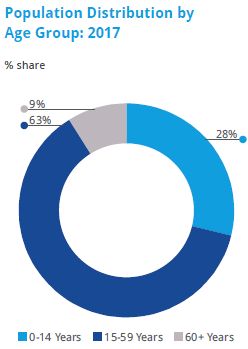
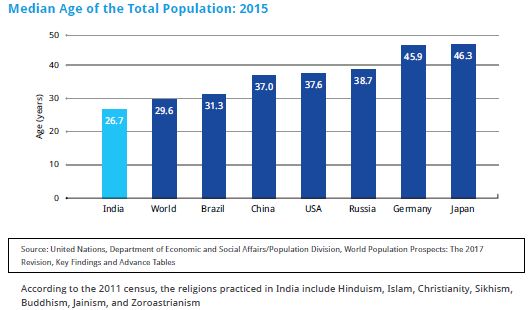
Language
The Constitution of India recognizes 22 different local languages, of which Hindi is used for official communication along with English at a national level. Other Indian languages recognized by the constitution are Assamese, Bengali, Gujarati, Kannada, Kashmiri, Konkani, Malayalam, Manipuri, Marathi, Nepali, Oriya, Punjabi, Sanskrit, Sindhi, Tamil, Telugu, and Urdu. However, according to the 2001 census, about 30 languages are spoken by more than a million native speakers, and 122 are spoken by more than 10,000 speakers. According to the 2011 census, literacy rates stand at 74.04% (82.14% for males and 65.46% for females).
Currency
The currency of India is the Rupee (ISO code: INR; symbol: `). The Reserve Bank of India, which is the central bank of the country, has the sole authority to issue banknotes and coins.
Business Hours
Typically, a work day is 8 hours long extending, from 9am to 5pm IST (GMT + 05:30), and working days vary between 5 to 6 days a week. Business hours vary from 8 to 10 hours a day, depending on the type of organization, i.e. government, private company, multinational corporation, etc.
Public Vacation Days7
India has three Federal vacation days:
- Republic Day – 26 January
- Independence Day – 15 August
- Mahatma Gandhi's Birthday – 2 October
In addition, there are about 14 gazetted vacation days and 31 restricted holidays in the official calendar. These public vacation days are set by every state government each year under the Negotiable Instruments Act–1881.
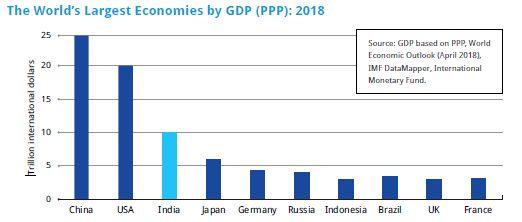
Economy
India is among the fastest growing economies in the world. It is the third largest economy in terms of gross domestic product (GDP) based on purchasing power parity (PPP) and the sixth largest by nominal GDP The service sector has been driving economic growth in India, accounting for 61.5% of Gross Value Added (GVA) growth (at constant prices), followed by the industry sector with a 23.1% share, and agriculture accounting for 15.4%.9 However, agriculture still has the largest share in employment (over 45% of the total workforce), followed by services (approximately 32%10).
Many new initiatives have been taken up by the government to facilitate investment and ease of doing business in the country. Noteworthy among them are initiatives such as Make-in-India, Invest India, StartUp India and e-biz Mission Mode Project under the National e-Governance Plan.11
The current business-friendly government's policies are expected to boost foreign investments further as it aims to:
- Revive growth by fueling investments in infrastructure and manufacturing
- Promote foreign direct investment (FDI) selectively in sectors
- Introduce administrative reforms to expedite project implementation
- Have a stable, predictable, and investor-friendly taxation regime
- Increase transparency and establish systems to eliminate corruption
- Strengthen and expand India's trade network with regional, bilateral, and multilateral trade agreements
According to the International Monetary Fund (IMF), India's GDP growth is estimated at 7.35% in 2018 compared to 6.74% in 201712.
India's economy has grown at a strong pace in recent years owing to the implementation of critical structural reforms, favorable terms of trade, and lower external vulnerabilities. Beyond the challenges faced in November 2016 due to demonetization, currency exchange initiative and policy actions should focus on reducing labor and product market rigidities to ease firm entry and exit, expand the manufacturing base, and gainfully employ the abundant pool of labor.13

Foreign trade: Exports of goods and services are estimated at 20% of the GDP in 2017-18, while imports are estimated to be 21.8%15. India's services sector registered an export growth of 5.7% in 2016-17. During April-September 2017-18, growth in services exports and services imports were robust at 16.2% and 17.4% respectively16.
Merchandise exports currently register at USD 271 billion for April 2017–February 2018 is estimated to surpass the USD 276 billion registered in 2016–17. Imports have also increased to approximately USD 417 billion (April 2017 – February 2019) compared to USD 382 billion in 2016-17.17
India's top export commodities include gems and jewelry; mineral fuels and oils; vehicles and parts and accessories; nuclear reactors, boilers, machinery, and mechanical appliances; pharmaceuticals; chemicals; textiles and apparel; machinery; cereals; and iron and steel. These account for nearly 50% of India's exports18.
Foreign direct investment: According to UNCTAD's 2015 survey of investment promotion agencies, India is one of the top three prospective destinations for FDI for 2015–2017, following China and USA19.
During April 2000–December 2017, cumulative FDI equity in- flows into India stood at USD 532 billion. April-December 2017 witnessed similar growth as compared to the previous period in 2016 registering FDI equity inflows of USD 35.9 billion20.
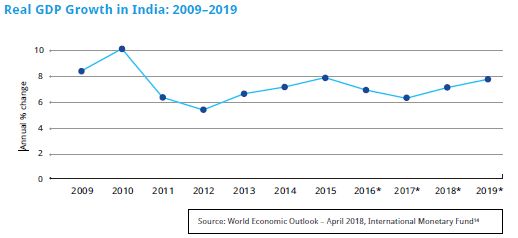
Country-Wise FDI Equity Inflows: 2016–17
From April 2000 to December 2017, cumulative FDI equity inflows from Mauritius stood at USD 125 billion, making it the largest source of FDI into India. During April-December 2017, Mauritius was also the top investor with USD 13.3 billion, followed by Singapore, Japan, Netherlands, the USA, the UK, Germany, UAE, France, and Cyprus 21.
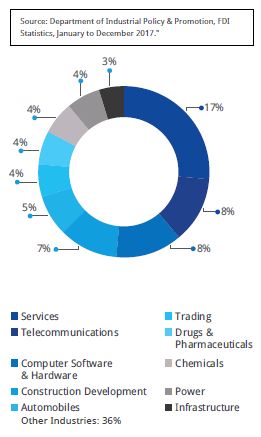
Sector-Wise FDI Equity Inflows: 2016–17
Considering sector-wise inflows, services attracted the highest amount of FDI in India and accounted for 17% of the total inflows during April 2000–March 2017. In 2017–18, telecommunications received the highest amount of FDI equity inflows followed by, computer software and hardware, the services sector, trading, automobiles, metallurgical industries, chemicals, power, drugs and pharmaceuticals, and construction development.
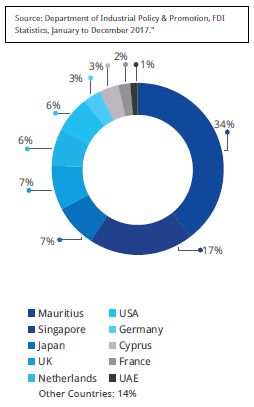
Foreign Portfolio Investments
Foreign Portfolio Investments (equity and debt) amounted to USD 21.66 billion in 2017–18 as compared to USD 7.6 billion in the previous financial year.22
As on 9 March 2018, India's foreign exchange reserves stood at USD 421.4 billion.23
For FDI regulations in India, please see the FDI section in Chapter 2.
To view the full article click here
Footnotes
1 India at a Glance, National Portal of India, https://india.gov.in/india-glance/profile, accessed 31 July 2017
2 My Government, National Portal of India, https://india.gov.in/my-government, accessed 31 July 2017
3 Supreme Court of India, http://supremecourtofindia.nic.in/constitution, accessed 31 July 2017
4 World Population Prospects: The 2017 Revision, Key Findings and Advance Tables, United Nations, Department of Economic and Social Affairs, Population Division (2017), https://esa.un.org/unpd/wpp/Publications/Files/WPP2017_KeyFindings.pdf, accessed 31 July 2017
5 Median Age of Population, World Population Prospects 2017, United Nations, Department of Economic and Social Affairs, Population Division, https://esa.un.org/ unpd/wpp/Download/Standard/Population/, accessed 3 August 2017
6 World Bank, India, http://www.worldbank.org/en/country/india/overview, accessed 3 August 2017
7 Calendar, National Portal of India, https://india.gov.in/calendar?date=2017–01, accessed 3 August 2017
8 IMF DataMapper, International Monetary Fund, http://www.imf.org/external/datamapper/datasets/WEO/1, accessed 30 May 2018
9 National Accounts Statistics 2017, Ministry of Statistics and Program Implementation, http://mospi.nic.in/publication/national-accounts-statistics-2017, accessed 3 August 2017
10 Volume 1, Report on Fifth Annual Employment – Unemployment Survey, Ministry of Labor and Employment, http://labourbureaunew.gov.in/UserContent/EUS_5th_1.pdf, accessed 3 August 2017
11 Economic Survey 2016–17, http://indiabudget.nic.in/es2016-17/echapter.pdf, accessed 3 August 2017
12 World Economic Outlook – April 2018, International Monetary Fund, http://www.imf.org/external/pubs/ft/weo/2018/01/weodata/weorept.aspx?sy=2016&ey=2023&ssm=1&scsm=1&ssd=1&sort=country&ds=.&br=0&pr1. x=61&pr1.y=9&c=924%2C534&s=NGDP_RPCH&grp=0&a=, accessed 26 April 2018
13 World Economic Outlook – April 2017, International Monetary Fund, http://www.imf.org/~/media/Files/Publications/WEO/2017/April/pdf/text.ashx, accessed 3 August 2017
14 World Economic Outlook – April 2018, International Monetary Fund, http://www.imf.org/external/pubs/ft/weo/2018/01/weodata/weorept.aspx?sy=2016&ey=2023&ssm=1&scsm=1&ssd=1&sort=country&ds=.&br=0&pr1. x=61&pr1.y=9&c=924%2C534&s=NGDP_RPCH&grp=0&a=, accessed 26 April 2018
15 First advance estimates of annual national income, 2017–18, PIB, http://pib.nic.in/newsite/PrintRelease.aspx?relid=175399, accessed 26 April 2018
16 During April-September 2017-18, Growth in Services Exports and Services Imports Robust, PIB, http://pibarchive.nic.in/newsite/PrintRelease.aspx?relid=175963, accessed 26 April 2018
17 RBI Bulletins, Foreign Trade, October 2017 – April 2018, https://www.rbi.org.in/Scripts/BS_ViewBulletin.aspx?Id=17518, accessed 26 April 2018
18 Commodity-wise Exports and Imports, Department of Commerce, http://commerce-app.gov.in/meidb/default.asp, accessed 26 April 2018
19 UNCTAD World Investment Report 2017, http://unctad.org/en/PublicationsLibrary/ wir2017_en.pdf, accessed 4 October 2017
20 Fact Sheet on Foreign Direct Investment, January to December 2017, Department of Industrial Policy & Promotion, http://dipp.nic.in/sites/default/files/FDI_FactSheet_21February2018.pdf, accessed 26 April 2018
21 Ibid
22 FPI/FII investment details, NSDL https://www.fpi.nsdl.co.in/web/Reports/Yearwise.aspx?RptType=6.accessed 26 April 2018 (1 USD = INR 66.78)
23 Foreign Exchange Reserves, RBI Bulletin – April 2018, RBI, https://www.rbi.org.in/Scripts/BS_ViewBulletin.aspx?Id=17519, accessed 26 April 2018
The content of this article is intended to provide a general guide to the subject matter. Specialist advice should be sought about your specific circumstances.


